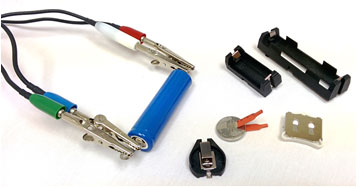Purpose of This Note
This application note discusses the differences between 2‑point and 4‑point measurements of batteries. These two typical setups are compared with Gamry’s battery holders for CR2032 coin cells and cylindrical 18650 batteries. Both holders allow direct‑contact Kelvin sensing.
EIS measurements are performed with two types of lithium‑ion batteries and different experimental setups. In addition, shorted lead measurements show the low‑impedance limits of Gamry’s 18650 and CR2032 battery holders.
Introduction
It is crucial to know the exact specifications when testing batteries or any other energy storage device. Many parameters affect the capability of a battery, e.g. electrolyte, electrode materials, and temperature.
Batteries have to pass different tests to check their capacity, voltage window, current rating, internal impedance, leakage current, cycle life, operational temperature range, as well as several impact tests.
In order to get correct, reliable, and reproducible results, researchers have to rely on their experimental setup. Wrong setups can heavily affect and falsify measurement results leading to inaccurate conclusions.
The following sections show by means of EIS experiments the influence of the setup on the actual result. Common battery setups are compared with Gamry’s direct‑contact 4‑terminal battery holders. Shorted lead measurements with dummy cells show the lower limits of Gamry’s battery holders.
Dual Cell CR2032 and 18650 Battery Holder
Figure 1 shows typical options to connect cylindrical batteries and coin cells. Some batteries can be purchased with soldered tabs on each electrode. They allow connecting alligator clips for measurements. If no tabs are available, simple battery holders with two contacts are often used.

Figure 1 – Selection of battery connectors for cylindrical batteries and coin cells.
Please note that all these setups have several drawbacks. Simple battery holders allow only 2-point configurations resulting in low measurement precision. Soldered tabs enable 4-terminal setups. However, keeping all leads separated while having proper cable alignment and not shorting the battery can be difficult.
Figure 2 shows Gamry’s battery holders for CR2032 coin cells (P/N 990-00314) and cylindrical 18650 batteries(P/N 990-00316). Both holders allow direct-contact Kelvin sensing on two batteries (single or in series). Additional resistances due to cables or connectors do not falsify the results and allow precise measurements.
View the Differences in Experimental Setups and read the complete application note at Gamry’s EIS of Batteries. You will have the opportunity to download this note in PDF format.

Figure 2 – Gamry’s dual cell CR2032 (left) and 18650 battery holder (right).
The battery contacts are split up to four separate parts. Current carrying and sense leads are completely separated from each other. The setup enables that their first direct electrical contact is at the surface of the batteries’ electrodes. In contrast to the setups shown in Figure 1, additional resistances from cables or connectors can be neglected.
All contacts are gold plated for high reliability. The PCB circuits are arranged in the way that mutual inductance effects and magnetic pickup from the sense leads are minimized.
Potentiostats can be connected using color coded banana connectors allowing stable electrical contacts. All connectors in the assembly are stationary. Hence batteries can be changed without disconnecting cables. The experimental setup stays the same. This allows reproducible measurements with different cells.
